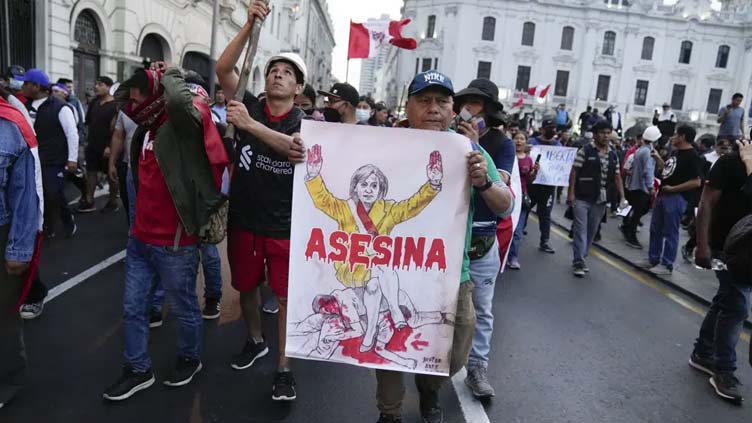Anger in rural areas fuels protests against Peru government

World
Their fury is such that their protests continued Monday despite the deaths of seven people.
ANDAHUAYLAS (AP) — The anger of Peruvians against their government is nowhere more visible than in Andahuaylas, a remote rural Andean community where the poor have struggled for years and where voters’ support helped elect now-ousted President Pedro Castillo, himself a peasant like them.
Their fury is such that their protests continued Monday despite the deaths of seven people, among them two young demonstrators over the weekend, including 17-year-old Beckham Romario Quispe Garfias.
As thousands of people spilled into the streets, Raquel Quispe recalled her brother as a talented athlete tired of feeling invisible in the eyes of politicians. He was named for English soccer great David Beckham and Romario, the Brazilian soccer phenomenon turned politician.
Clouds above her, she stood outside the hospital where his body was kept, and with a simmering anger in her voice, at times betrayed by tears, she summed up what drove him and others to protest since Castillo’s ouster last week: an exclusionary democracy.
“For them, those who are there in Congress, the only opinion that is valid is that of Peruvians who have money, of wealthy people,” said Quispe, an early childhood education teacher.
“They do whatever they want. For them... the vote of the provinces is not valid, it is useless. But the vote of the people of Lima is taken into account. That is an injustice for all of Peru.”
About 3,000 people gathered in the streets of Andahuaylas Monday, to protest and to mourn and pay their respects before the white caskets of the young men who died over the weekend. Across the community, rocks were scattered on roads still marked by simmering fires. An airstrip used by the armed forces remained blocked, black smoke still etched on a nearby building.
Demonstrators across rural communities, including Andahuaylas, continued to call on President Dina Boluarte to resign and schedule general elections to replace her and all members of Congress. They also want authorities to free Castillo, who was detained Wednesday when he was ousted by lawmakers after he sought to dissolve Congress ahead of an impeachment vote.
While protesters have also gathered in Lima, the capital, the demonstrations have been particularly heated in rural areas that were strongholds for Castillo, a former schoolteacher and political newcomer from a poor Andean mountain district.
Protesters on Monday went a step further by blocking access to an international airport for several hours in southern Peru and occupying its runway. Demonstrations in Arequipa, where the airport is located, left one protester dead, Minister of Defense Alberto Otarola told lawmakers during a session of Congress focused on the civil unrest.
The Ombudsman’s Office of Peru reported that seven people had died since the demonstrations began Wednesday. Five of them died Monday. All seven deaths happened outside Lima, including four in Andahuaylas.
The escalation came even after Boluarte gave in to protesters’ demands hours earlier, announcing in a nationally televised address that she would send Congress a proposal to move up elections to April 2024 — a reversal of her previous assertion that she should remain president for the remaining 3 1/2 years of her predecessor’s term.
Boluarte, in her address to the nation, also declared a state of emergency in areas outside Lima, where protests have been particularly violent.
“My duty as president of the republic in the current difficult time is to interpret ... the aspirations, interests and concerns ...of the vast majority of Peruvians,” Boluarte said in announcing she would propose early elections to Congress.
Boluarte, 60, was swiftly sworn in Wednesday to replace Castillo, hours after he stunned the country by ordering the dissolution of Congress, which in turn dismissed him for “permanent moral incapacity.” Castillo was arrested on charges of rebellion.
Members of Boluarte’s Cabinet appeared before Congress Monday to give an account of the protests. Far-right lawmaker Jorge Montoya demanded appropriate measures to end the unrest, telling Castillo’s supporters that now that he has been removed that “chapter is closed.”
“These are not acts of protest, they are acts of terrorism that must be drastically punished,” Montoya said. “You cannot defend a situation that is at the extremes.”
Peru has had six presidents in the last six years. In 2020, it cycled through three in a week.
The latest presidential crisis is taking place as the Andes and its thousands of small farms struggle to survive the worst drought in a half-century. The country is also experiencing a fifth wave of COVID-19 cases.
Castillo’s supporters had hoped that the populist outsider would address some of the challenges they have long faced. But during his 17 months in office, Castillo could not achieve any signature project and faced the racism and discrimination that his impoverished supporters often experience.
In Andahuaylas, about 80% of voters who cast a ballot during the runoff election last year supported Castillo. His proposals included rewriting the country’s constitution, which was last drafted and approved in 1993 during the government of Alberto Fujimori, the disgraced former president whose daughter, Keiko, lost the presidency to Castillo.
Rosario Garfias was among those demonstrating outside the hospital where her 17-year-old son’s body was being held. She expressed heartbreak over her son’s death, speaking in Quechua, one of Peru’s Indigenous languages.
“My mother is making a complaint in her language. I know that many do not understand her, not even Congress understands it,” said her daughter, Raquel Quispe.
“She is saying that ... she is hurting deeply because they have killed him, like in a slaughterhouse. And my mom, like my family, asks for justice for my brother.”


